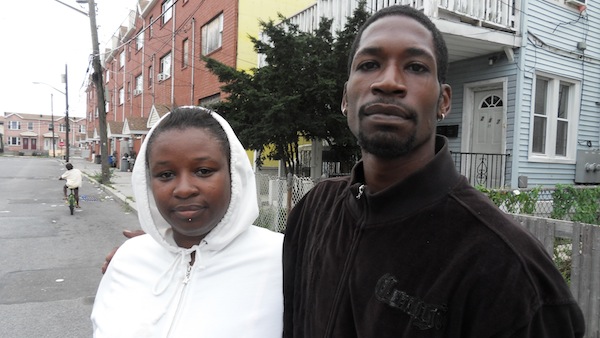
Photo by: Patrick Arden
Regina Day and Mike Porter said this morning that they planned to stay in Rockaway.
In the calm before the storm early Saturday morning, Neville Plumber marched his family up Edgemere Avenue in Far Rockaway. With his wife and two sons behind him, Plumber pulled wheeled luggage and a leashed dog to the A train at Beach 36th Street.
The night before they had seen Mayor Michael Bloomberg on TV announcing the mandatory evacuation of their neighborhood before the arrival of Hurricane Irene. “We knew we better leave,” said Plummer, a cabdriver who walks with a cane. His wife’s mother would take them into her Flatbush home. Many of his neighbors, however, were staying put. “They think the mayor’s just trying to make up for missing the snowstorm last winter.”
The Rockaway peninsula supposedly took its name from the Lenape word for “place of sands,” and now the wind sent sand across Edgemere from the nearby beach, where the approaching storm had already pushed waves up to six feet high. A century ago this street ran through a summer resort community, and in recent years developers built attractive brick homes and condos on empty beachfront lots. Many of these new places never sold, so the developers turned to city-subsidized renters. Plumber is one.
On a nearby street corner, Carol Sanchez leaned out a car window, waiting for her husband to come down from their first-floor apartment. They planned to stay with family on Manhattan’s Lower East Side, their old neighborhood before they moved into a newly-built home six years before. The apartments next door had plywood nailed over the windows, but that wasn’t in preparation for the storm. “Those places are empty,” Sanchez explained. “They just covered the windows.”
Down the block, close to the 29th Street beach, a group of five men joked on the sidewalk in front of P.S. 43, a K-8 school that was in the news last year after a 13-year-old boy was shot in the leg a couple of blocks away. “We’re all school cleaners,” said James Taylor, who had no car and didn’t see how he could make the last train off the peninsula before service shut down at noon. “Me, my mother, and sister are all staying,” he said.
A group of neighbors huddled in the middle of 31st Street and debated whether to leave or to stay. A rooster strutted over from the community garden.
“That’s the safe house,” said Regina Day, pointing to the three-year-old brick home owned by Kevin King. Everyone laughed.
“Y’all can stay, but then I’ll leave,” joked King, a construction worker.
“Nobody’s been by here to say we should leave,” said Day’s husband, Mike Porter, a tow-truck driver currently collecting Social Security disability. “You’d think if this was a serious evacuation, someone would ride around here with a loudspeaker and siren. We’re maybe 250-300 feet from the water, and I haven’t seen that.”
“Someone would come for us,” Day agreed.
Porter and Day live in a first-floor apartment with their four-year-old son, Mekhi. They pay $1,300 a month for two bedrooms. “Leaving and coming back seems like we’ll be dealing with a worse situation,” Porter said. “I went through that snowstorm in 1996 — the wind picked my sister off the ground. It’s about staying in the house and going upstairs if necessary.”
Tina Parker tried to convince them to leave. “I’ve been in two hurricanes in Alabama, and I’m not taking a chance,” she said. “My son has seizures — I need to be somewhere where I can get help.” She had already packed a bag and would soon be heading to a city evacuation center at John Adams High School in Ozone Park.
Standing on 32nd Street, Linda Smith looked worried. Her mother-in-law was refusing to leave her apartment in the Seaview Towers, a pair of 20-story buildings with a HUD-backed mortgage and tax abatement from the Mitchell-Lama program. Most tenants receive rental subsidies.
“She’s in a wheelchair,” said Smith, who was taking her 13-year-old daughter to a hotel in Queens. “I came here to convince her and her husband it’s not safe to stay.” She looked at the sky. “It just smells different.”
A policeman leaned against a wrought iron fence on Edgemere.
“This is a mandatory evacuation, right?” Smith asked the cop.
“Yes, it is,” he said.
“Will you be knocking on doors to tell people to leave?”
“Yes,” said the policeman said. “Not now, but later on.”
“If I go further into Queens, I’ll be OK, correct?”
“We’d rather you go to a shelter,” he said. “But we can’t force anyone to go.”
A line formed outside John Adams High School, a hurricane evacuation center in Ozone Park. Inside the school’s foyer, confusion reigned. By 10 a.m. Saturday, the center’s beds had all been claimed. One police officer complained the school had just 200 cots and no air conditioners or fans. Busloads of disabled people were sent elsewhere, and travelers arrived after flights were canceled at JFK Airport.
“We can’t turn people away,” she said. “We don’t have enough volunteers. There are other schools open, but people keep coming here. We can’t take the whole Rockaways.”
Some had gotten their yellow wristbands the night before. Sanford Klein and his mother showed up early Saturday and received beds. “We’re lucky, I guess,” he said. Many of his neighbors chose to stay in their homes. “They were incredibly calm.”








